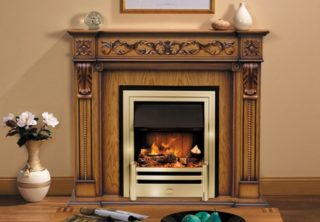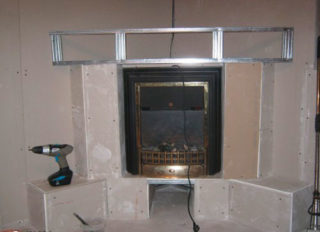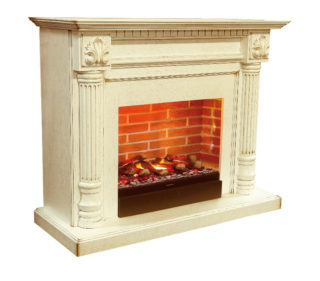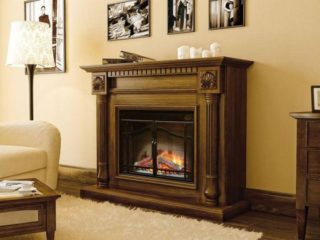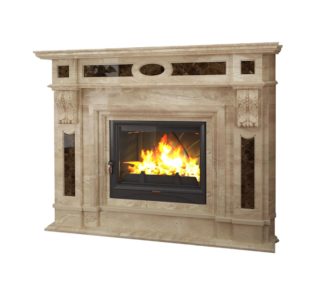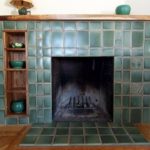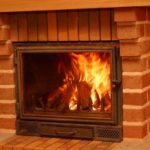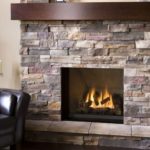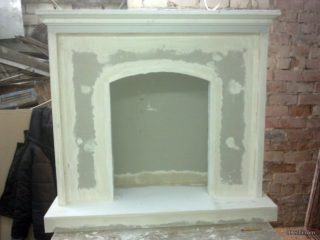The word fireplace is firmly associated with the flames, comfort and warmth of the house. To afford a real hearth in which firewood burns, apartment owners can not. Spending money on a factory portal for a fireplace is not necessary. Having studied the ideas and spending a little time, the decor element is created with your own hands.
Varieties of Portals
Fireplaces are complex devices; they are responsible for choosing an option for purchase or self-made.
At the design stage, determine:
- purpose - heating, decorative function, combined version;
- type of energy carrier - firewood, biofuel (ethanol), electricity, natural gas;
- type of allocation;
- portal style;
- type of building material for manufacture.
Functions and Fuel
Devices designed for heating can burn wood, coal or gas.
In urban apartments, the installation of products of this kind is impossible. To remove deadly combustion products and caustic smoke, you need a chimney with high productivity. Connecting the pipe to the general access hood is prohibited by sanitary standards. In addition, neighbors will certainly receive complaints to which smoke will enter the housing.
Electric fireplaces are equipped with heaters of 1.5–2.5 kW, capable of maintaining the temperature in a room with an area of 10–18 m2. Given the cost of electricity, this method of heating is extremely expensive. Devices turn on for a short time. Electric foci combine the functions of a decorative element and heating.
To create the illusion of flame, electric fireplaces are equipped with special bulbs.
Biofuels are obtained from the remains of canola, coconut, and soy. Ethanol is expensive to sell and it is unprofitable to heat a room with it. Fireplaces serve as a decorative element.
Manufacturers add perfumes with various odors to biofuels. Special additives give the flame a natural color, and sea salt causes a crackling effect.
Installation options
The choice of model depends on the tasks, the size of the room, the desired style.
There are fireplaces:
- built-in - are placed in specially designed niches and recesses, the facade of the portal does not protrude beyond the line of the wall;
- half-open - part of the structure is located in a niche, and the front part protrudes into the room;
- corner models are suitable for small premises, when it is necessary to economically relate to the usable area;
- wall options do not have contact with the floor, the size and weight of such products are small;
- open fireplaces are usually located in the center of the room, they serve as a place around which you can gather a large company.
For each option, choose the appropriate portal design.
Stylistic solutions
Often portals of fireplaces are made in the form of letters P or D.
The first option is correlated with the French, Old German and English styles. Similar structures are characteristic of minimalism and hi-tech.
In the modern and country directions, they prefer designs that are similar in configuration to D.
Modern design trends highlight at least 15 styles of interior design. Only professional designers with academic architectural education can understand all the intricacies.
The basic requirements for how the fireplace portal should look in order to be combined with the overall design are compiled in a table.
| Style | Colors | Material | The form |
| Vanguard | The combination of contrasting shades, black, white, red | New, unconventional (laminate, glass, chrome steel) | Unusual with a minimum of decorative elements |
| Empire | Blue, White, Red, Pink, Gold | Solid wood, carved jewelry, gilding | Massive |
| Art Deco | Contrast: black and white, beige and chocolate, etc. | Dear natural (wood, marble, stone) | Highly geometrically accurate |
| Baroque | The main one is gold, brown and green, blue and gold, etc. | Stone wood with inlay, carving | Massive, voluminous |
| Country (rustic) | Natural, dim | Natural stone tree | Emphasized plain, rude |
| Classicism | Pastel, Cream, Beige | Natural | Wide, massive, voluminous |
| Contemporary (close to hi-tech and minimalism) | Black, white, gray, pastel shades | Natural, but acceptable MDF, plastic, metal, glass | Clear lines, minimal decoration |
| Loft | Terracotta, shades of gray | Brickwork or imitation | Massive or small version on legs |
| Minimalism | The main one is white, shades of pastel and gray colors | Stone, brick | Lack of fillets and decor, fine lines, right angles |
| Modern | Muted natural shades | Wood, tile, glass trim, marble or stone "countertop", nothing "cheap" in appearance | Any in style of the rest of the furniture |
| Provence | Light shades | Only natural or looking natural | Massive with artificially aged trim |
| Scandinavian | Main - white, pastel color | Stucco, ornaments, tiles, mirrors | Functional, without extra details |
| High tech | Metallic, black, white, gray | Metal, glass, mirrors | Direct forms, the portal is set in sight, a minimum of decor |
| Eclecticism | Natural, vibrant or muted | Artificially aged metal, brick, stone | The main element of the interior, a lot of decor |
| Eco style | Natural shades of white, brown, light blue, etc. | Natural wood, stone, plaster | Preferably in the style of handmade, possible flaws in the decoration, asymmetrical decor |
When buying, it is advisable to take into account the requirements given in the table, but you need to focus on financial capabilities and existing design solutions.
On sale are a variety of options for interior items, but you can build a portal for an electric fireplace with your own hands.
Available materials
In apartments, most often with their own hands they build portals for an electric fireplace. In this case, any available material is suitable: wood, laminate, gypsum, artificial marble plates.
Choosing a material, evaluate:
- work experience;
- tool availability;
- the complexity of processing trim parts.
Natural wood
Ready-made portals made of natural wood are expensive, because they are most often hand-made by experienced cabinet makers.
Self-made framing will be much cheaper.
For work you will need:
- drill or screwdriver;
- hacksaw or electric jigsaw;
- screwdrivers, level, tape measure or ruler, construction pencil.
Between themselves, the parts are fastened with furniture ties, self-tapping screws, studded joints. In the latter case, carpentry glue is needed.
Wood is a universal material from which fireplace portals are assembled, suitable for most styles. Decorate the side and top parts with carvings or get ready-made decor. Before finishing, the tree is treated with flame retardants and an antiseptic. The topcoat is paint, decorative varnish or primer.
Drywall
A base is made from drywall, which is then decorated with decorative elements. This is the easiest option.
Before buying, carefully calculate the necessary materials: galvanized profile, the size of the drywall sheets. Self-tapping screws are purchased with a margin. On average, 5 pcs are needed to secure 1 linear meter of edge. fasteners.
The design is lightweight, so installation on partitions is allowed.
If the fireplace will serve to heat the room, GKLO stoves are purchased - a fireproof finish. Outwardly, it differs from ordinary GKL plates with a pinkish color.
Finishing is carried out by plaster putty. For painting use acrylic paints.
Polyurethane
Decor made of polyurethane is used only in decorative fireplaces, with strong heating it melts. In construction stores they sell corner and central parts, plates imitating columns and borders. Polyurethane blanks often look like stucco. Acquire ready-made kits or select parts according to size. The figure, consisting of straight lines, allows you to precisely adjust the dimensions to the finished skeleton of the portal.
The mass of the material is small, therefore, special glue is used for attaching to the base frame. Polyurethane can be painted. Such decoration is combined with ceramic tiles, natural and artificial stone.
It is necessary to accurately calculate the dimensions of the “furnace” and the finish, so it is better to first prepare polyurethane parts, and then build a base for their size.
Gypsum
A frame is built from gypsum tongue-and-groove blocks, which are then finished with any material you like. Blocks are purchased, which are used in construction for the construction of interior partitions. The thickness of such "bricks" is only 10 cm, so the portal will take up less space than in brick construction. The blocks are lightweight and there is no need to build a foundation.
They fasten the tongue-and-groove blocks with special gypsum-based glue.
Buy blocks and glue from the same manufacturer - they are the same color, which will make it easier to finish.
After the glue has dried, the finish is done with gypsum putty, painting or fixing to the basis of decorative elements.
Marble
On sale there are natural and artificial marble slabs, columns, countertops.
It’s impossible to create a marble portal for a fireplace with a complex shape with your own hands. It will require special equipment and professional masonry skills. For the home, they choose and purchase finished products.
Marble fireplaces are durable, easy to wash. Artificial material is in no way inferior to natural, easy to grind when scratches occur.
For independent construction, they acquire flat marble tiles, which are mounted on a brick base.
Brick
The construction of brick portals in a multi-storey building should be treated with caution. The material is heavy, massive construction may not withstand the overlap.
When selling or re-registering an apartment, the registration service has a claim; they may require dismantling the structure.
Ceramic tiles
Tile as a finishing material is suitable for any type of fireplace. The material is heat resistant. For foci that are heated, a special adhesive is used during installation.
Different types of tiles imitate brick or tiles, some similar to natural stone. The color scheme is unlimited, they are ready to deliver the preferred version of the trade enterprise even from foreign countries.
A rock
When working, you will need the skills of a builder-masonry worker, so only experienced professionals take up the decoration with natural stone. With such a device, problems similar to brick structures can arise.
Elements can have various shapes and colors.
Artificial stone is made from gypsum and cement compounds, plastic, acrylic composites.
- Ceramic tile
- Brick
- A rock
Manufacturing sequence
Build a portal in several steps, each of which requires a thorough approach.
Stages of construction:
- choice of design solutions;
- design;
- counting and purchasing materials;
- frame construction;
- decorative finish.
The easiest option is to build a portal with a drywall base.
After choosing the appearance, careful measurements are taken of the room, the length and height of the walls.
The fireplace should not look "toy" or occupy most of the free space. Take into account the location of furniture and home appliances. For example, provide for the possibility of placing a television or music center.
Complex equipment is not placed above the fireplace-heater - upward convection flows raise dust, which enters the body, clogs the ventilation holes. Hot air adversely affects electronic circuit components.
It is better to consider the sequence of construction on the example of the construction of a portal from drywall, which is finished with various materials.
Algorithm for mounting a wall portal:
- Furrows are made in the wall to bring the network wire to the electric fireplace, they prepare a place for installing the outlet.
- Lay the wire, install the body of the outlet, close the furrows with gypsum or alabaster.
- Putty the wall at the place of installation of the fireplace.
- Mark the mounting points of the frame guide elements.
- Galvanized profiles are fastened to the wall and floor, on which drywall will be mounted. The distance between the guides should not exceed 50 cm - if necessary, install additional segments. For fixing to the wall, dowels are used, the profiles are interconnected with screws or rivets.
- Sheathe the frame with drywall. First fasten the inner lining, then the outer walls.
- Install electrical fittings for a lamp that simulates a flame or heater.
- Plasterboard frame is trimmed with the selected finishing material.
A self-made portal for a fireplace can become a unique decoration of the interior. For work, you do not need a complex tool and expensive components. The project is chosen from their ideas about design. Multifunctional designs in addition to aesthetic pleasure will make the stay in the room comfortable and enjoyable.
